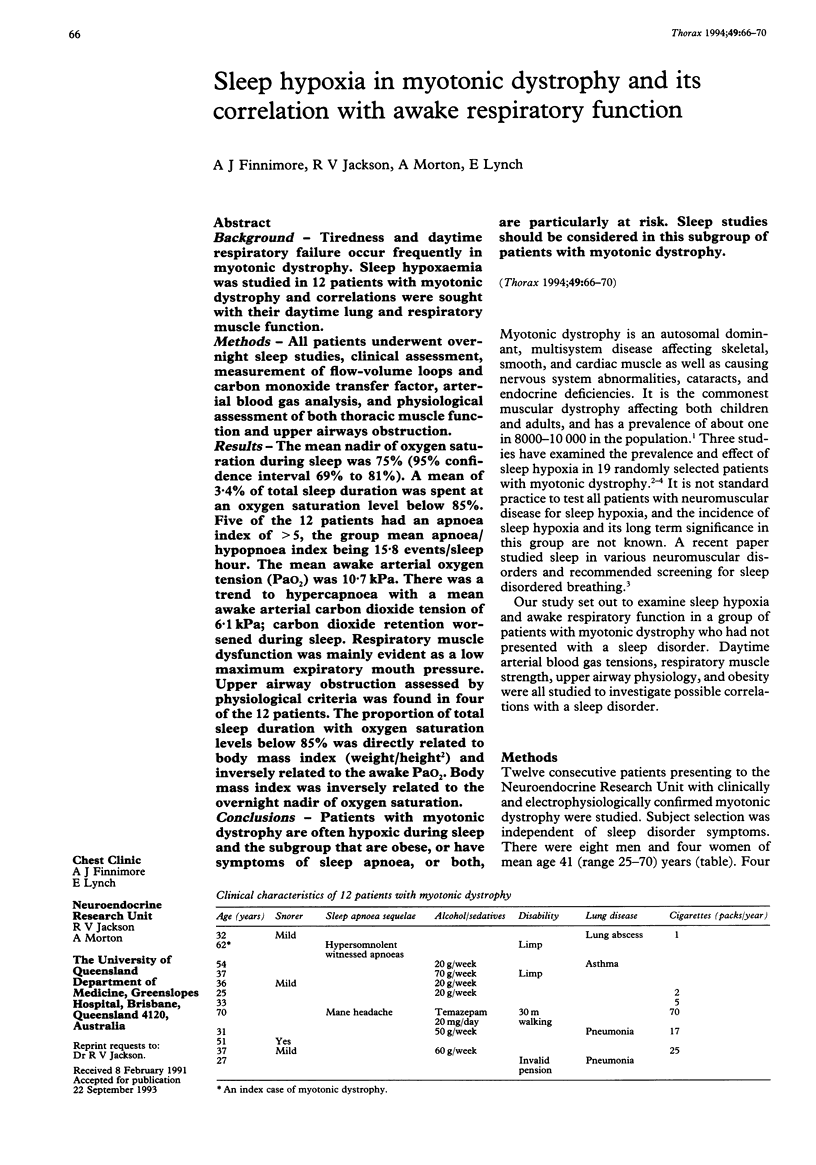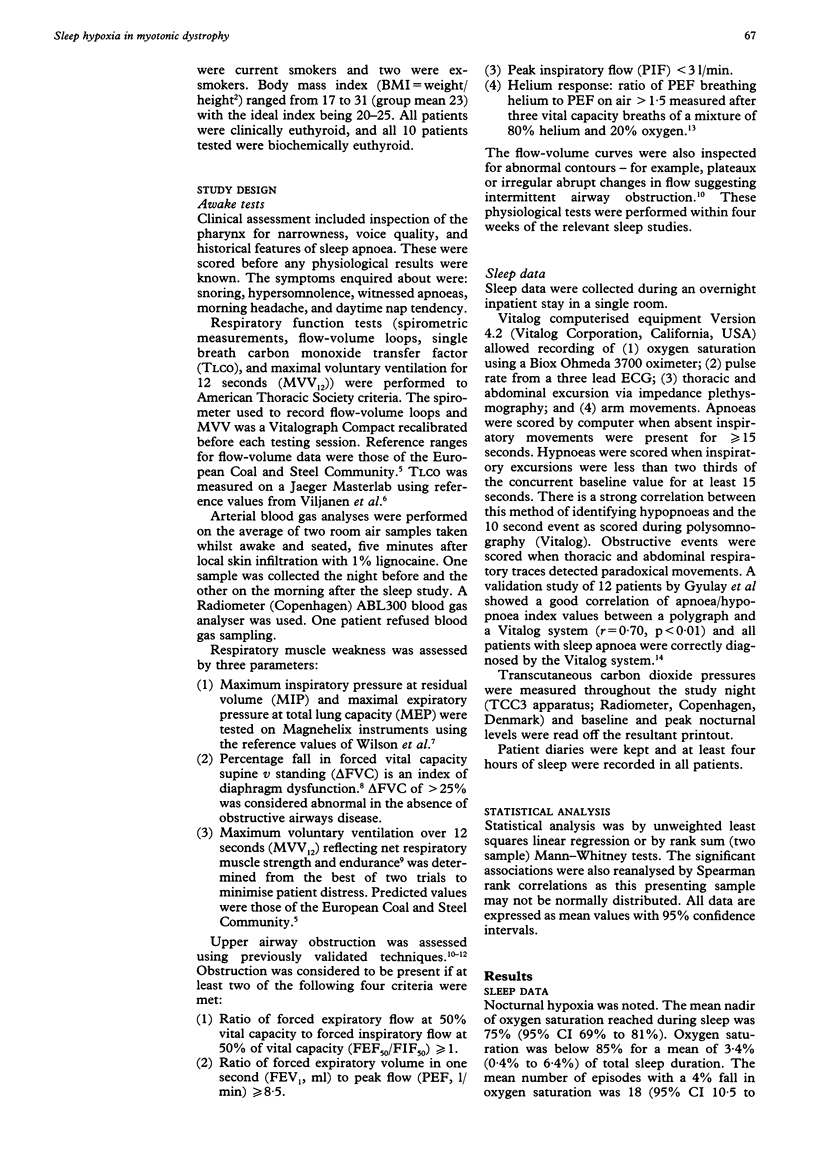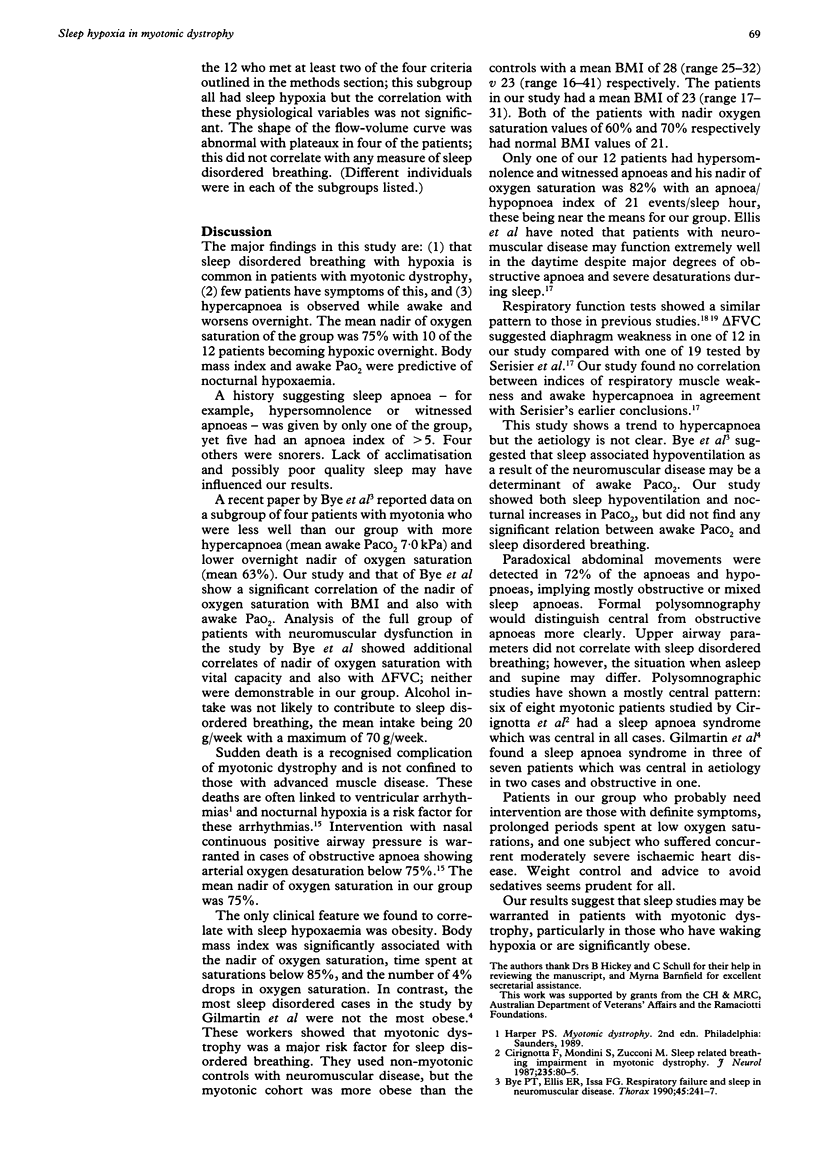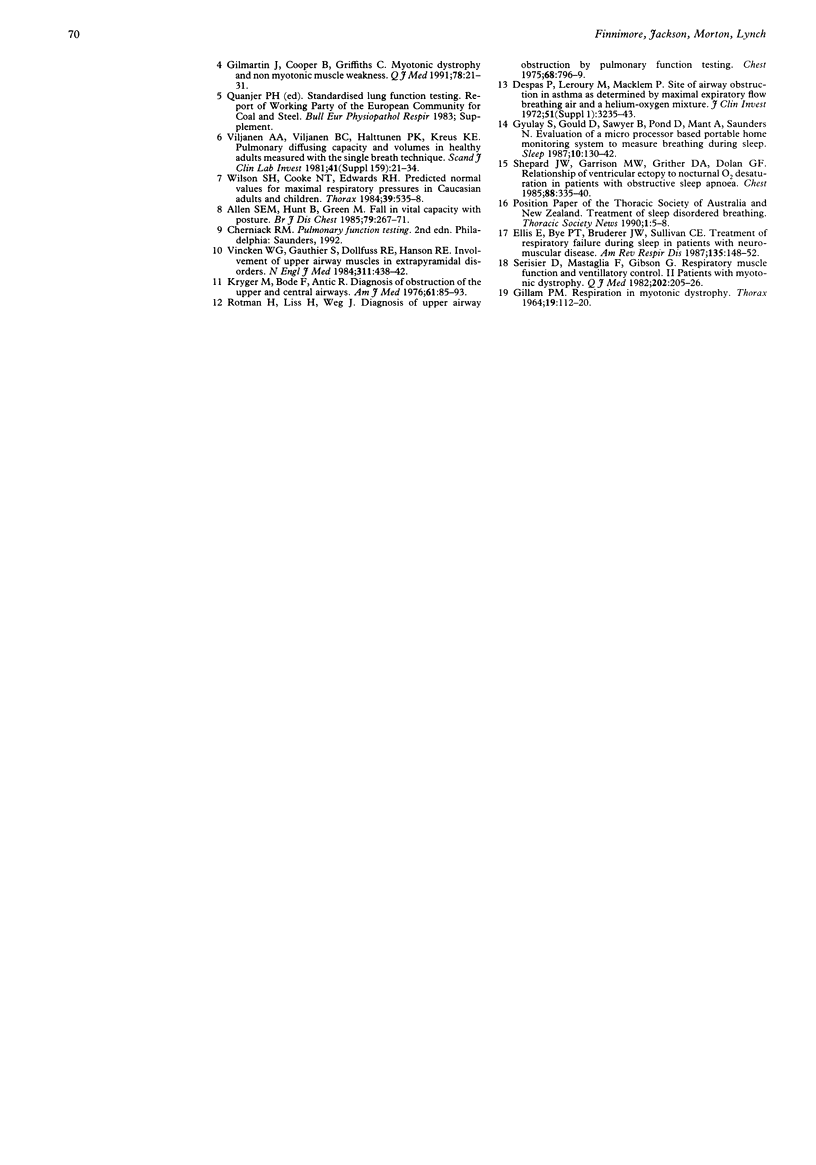Abstract
BACKGROUND--Tiredness and daytime respiratory failure occur frequently in myotonic dystrophy. Sleep hypoxaemia was studied in 12 patients with myotonic dystrophy and correlations were sought with their daytime lung and respiratory muscle function. METHODS--All patients underwent overnight sleep studies, clinical assessment, measurement of flow-volume loops and carbon monoxide transfer factor, arterial blood gas analysis, and physiological assessment of both thoracic muscle function and upper airways obstruction. RESULTS--The mean nadir of oxygen saturation during sleep was 75% (95% confidence interval 69% to 81%). A mean of 3.4% of total sleep duration was spent at an oxygen saturation level below 85%. Five of the 12 patients had an apnoea index of > 5, the group mean apnoea/hypopnoea index being 15.8 events/sleep hour. The mean awake arterial oxygen tension (PaO2) was 10.7 kPa. There was a trend to hypercapnoea with a mean awake arterial carbon dioxide tension of 6.1 kPa; carbon dioxide retention worsened during sleep. Respiratory muscle dysfunction was mainly evident as a low maximum expiratory mouth pressure. Upper airway obstruction assessed by physiological criteria was found in four of the 12 patients. The proportion of total sleep duration with oxygen saturation levels below 85% was directly related to body mass index (weight/height2) and inversely related to the awake PaO2. Body mass index was inversely related to the overnight nadir of oxygen saturation. CONCLUSIONS--Patients with myotonic dystrophy are often hypoxic during sleep and the subgroup that are obese, or have symptoms of sleep apnoea, or both, are particularly at risk. Sleep studies should be considered in this subgroup of patients with myotonic dystrophy.
Full text
PDF




Selected References
These references are in PubMed. This may not be the complete list of references from this article.
- Allen S. M., Hunt B., Green M. Fall in vital capacity with posture. Br J Dis Chest. 1985 Jul;79(3):267–271. [PubMed] [Google Scholar]
- Bye P. T., Ellis E. R., Issa F. G., Donnelly P. M., Sullivan C. E. Respiratory failure and sleep in neuromuscular disease. Thorax. 1990 Apr;45(4):241–247. doi: 10.1136/thx.45.4.241. [DOI] [PMC free article] [PubMed] [Google Scholar]
- Cirignotta F., Mondini S., Zucconi M., Barrot-Cortes E., Sturani C., Schiavina M., Coccagna G., Lugaresi E. Sleep-related breathing impairment in myotonic dystrophy. J Neurol. 1987 Dec;235(2):80–85. doi: 10.1007/BF00718014. [DOI] [PubMed] [Google Scholar]
- Despas P. J., Leroux M., Macklem P. T. Site of airway obstruction in asthma as determined by measuring maximal expiratory flow breathing air and a helium-oxygen mixture. J Clin Invest. 1972 Dec;51(12):3235–3243. doi: 10.1172/JCI107150. [DOI] [PMC free article] [PubMed] [Google Scholar]
- Ellis E. R., Bye P. T., Bruderer J. W., Sullivan C. E. Treatment of respiratory failure during sleep in patients with neuromuscular disease. Positive-pressure ventilation through a nose mask. Am Rev Respir Dis. 1987 Jan;135(1):148–152. doi: 10.1164/arrd.1987.135.1.148. [DOI] [PubMed] [Google Scholar]
- GILLAM P. M., HEAF P. J., KAUFMAN L., LUCAS G. B. RESPIRATION IN DYSTROPHIA MYOTONICA. Thorax. 1964 Mar;19:112–120. doi: 10.1136/thx.19.2.112. [DOI] [PMC free article] [PubMed] [Google Scholar]
- Gilmartin J. J., Cooper B. G., Griffiths C. J., Walls T. J., Veale D., Stone T. N., Osselton J. W., Hudgson P., Gibson G. J. Breathing during sleep in patients with myotonic dystrophy and non-myotonic respiratory muscle weakness. Q J Med. 1991 Jan;78(285):21–31. [PubMed] [Google Scholar]
- Gilmartin J. J., Cooper B. G., Griffiths C. J., Walls T. J., Veale D., Stone T. N., Osselton J. W., Hudgson P., Gibson G. J. Breathing during sleep in patients with myotonic dystrophy and non-myotonic respiratory muscle weakness. Q J Med. 1991 Jan;78(285):21–31. [PubMed] [Google Scholar]
- Gyulay S., Gould D., Sawyer B., Pond D., Mant A., Saunders N. Evaluation of a microprocessor-based portable home monitoring system to measure breathing during sleep. Sleep. 1987 Apr;10(2):130–142. doi: 10.1093/sleep/10.2.130. [DOI] [PubMed] [Google Scholar]
- Kryger M., Bode F., Antic R., Anthonisen N. Diagnosis of obstruction of the upper and central airways. Am J Med. 1976 Jul;61(1):85–93. doi: 10.1016/0002-9343(76)90048-6. [DOI] [PubMed] [Google Scholar]
- Rotman H. H., Liss H. P., Weg J. G. Diagnosis of upper airway obstruction by pulmonary function testing. Chest. 1975 Dec;68(6):796–799. doi: 10.1378/chest.68.6.796. [DOI] [PubMed] [Google Scholar]
- Serisier D. E., Mastaglia F. L., Gibson G. J. Respiratory muscle function and ventilatory control. I in patients with motor neurone disease. II in patients with myotonic dystrophy. Q J Med. 1982 Spring;51(202):205–226. [PubMed] [Google Scholar]
- Shepard J. W., Jr, Garrison M. W., Grither D. A., Dolan G. F. Relationship of ventricular ectopy to oxyhemoglobin desaturation in patients with obstructive sleep apnea. Chest. 1985 Sep;88(3):335–340. doi: 10.1378/chest.88.3.335. [DOI] [PubMed] [Google Scholar]
- Viljanen A. A., Viljanen B. C., Halttunen P. K., Kreus K. E. Pulmonary diffusing capacity and volumes in healthy adults measured with the single breath technique. Scand J Clin Lab Invest Suppl. 1982;159:21–34. [PubMed] [Google Scholar]
- Vincken W. G., Gauthier S. G., Dollfuss R. E., Hanson R. E., Darauay C. M., Cosio M. G. Involvement of upper-airway muscles in extrapyramidal disorders. A cause of airflow limitation. N Engl J Med. 1984 Aug 16;311(7):438–442. doi: 10.1056/NEJM198408163110704. [DOI] [PubMed] [Google Scholar]
- Wilson S. H., Cooke N. T., Edwards R. H., Spiro S. G. Predicted normal values for maximal respiratory pressures in caucasian adults and children. Thorax. 1984 Jul;39(7):535–538. doi: 10.1136/thx.39.7.535. [DOI] [PMC free article] [PubMed] [Google Scholar]


